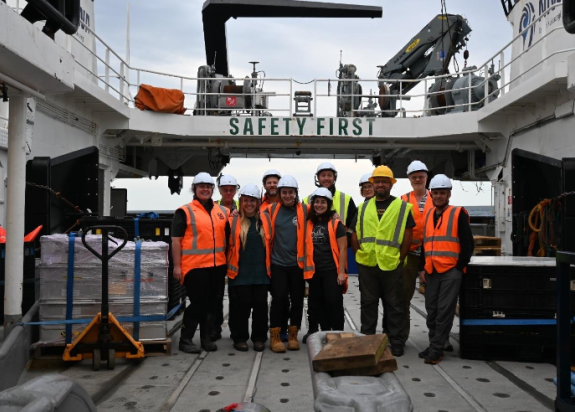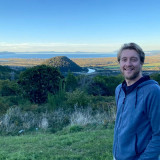Summary of Voyage #3: Seafloor sediment coring & more geophysics
The focus of our third research voyage, in October 2023, was to collect sediment cores to establish eruption histories of Whakaari and Tūhua. We also deployed Ocean Bottom ElectroMagnetic instruments (OBEM) to continue to instrument coverage from previous voyages.
Seafloor Sediment Collection
Being close to Whakaari and Tūhua, the research sought to provide new information on the eruptive history of these volcanoes over the past 20,000 years to get a better idea of how often these volcanoes have erupted in the past, and how large their eruptions have been.
Marine sediment cores(external link) are likely to preserve more complete records of Tūhua and Whakaari’s explosive eruptive histories than what is found on land. Our voyage goal was to collect around 18 marine sediment cores from around the two islands via a Kullenberg piston corer. This technique provides a sample of the layers of the seafloor that includes marine sediment and volcanic ash layers, known as tephra, that provide evidence of past eruptions that can be dated and fingerprinted to a source volcano by geochemistry.
Core sampling sites around Tūhua and Whakaari were selected based on trying to recover the most complete record of volcanism for each of the volcanoes over the longest possible time interval. Regions that appeared flat in bathymetry with fine-grained sediment were preferred because they are ideal conditions for recovering long cores. Other important parameters considered during planning was the likely sedimentation rate, the depths of the sites, the nature of the substrate being cored and any marine reserve areas (e.g., Volkner rocks).
Using details preserved in previously collected core records, we targeted a combination of proximal core sites (~10 km away from the islands) to gain new insights into the most recent eruptive record in all possible directions of wind dispersal, as well as distal core sites (~20 km away from each of the volcanoes) to access older events.


The coring operation took place on the 12-hour overnight shifts (midnight-midday), and scientists worked with vessel staff to retrieve and process cores. The coring science team consisted of Simon Barker (lead, VUW), Jacqueline Grech Licari (PhD student VUW), Pip Tildesley (PhD student, VUW) and Jenny Stein (GNS). The science team were supported by Erica Spain (NIWA technician) who oversaw core retrieval with vessel staff. Additional support was provided by MT scientists Jacob Perez (SCRIPPS), Ted Bertrand (GNS) and Goran Boren (Adelaide University).
During deployment, the corer assembly is lowered by winch to the seafloor at predetermined locations. On each deployment, the trigger weight hit the bottom first, releasing the weight on the trigger arm and allowing the corer to free-fall ~3 m towards the seafloor, penetrating the bottom sediment like a giant straw. The entire trip boasted excellent weather and coring conditions, allowing us to retrieve a total of 37 cores (16 from Tūhua and 21 from Whakaari), each 7 cm in diameter and up to 5.4 m in length. This collectively represented ca. 105m of total core material.
Upon collection, the cores were initially stood vertically and tied to the bulkhead for about 24 hours to allow settling and removal of any seawater that accumulated at the core top. A portable 40 ft container on the trawl deck served as an onboard core processing facility. Cores were then measured and cut to 90 cm sections, logged, photographed and packaged for storage in the temperature-controlled lab. Sampling was undertaken on board, as well as back onshore. Read more about the sample processing here.

MT & Magnetics
The team deployed 80 OBEM instruments in two sets of 40 deployments, using the same methods as for the first voyage.(external link) 40 instruments were left on the sea bed and will be recovered in 2024 as part of our fourth research voyage.
During transits between Whakaari and Tūhua, and between coring shifts, the team deployed the seaspy magnetometer. The new data collected helps to connect the TAN2306 voyage data (our second voyage)(external link) with existing datasets in the Bay of Plenty.


VOYAGE INFORMATION
TAN2315 RV Tangaroa
Dates: 12 – 25 October 2023
Lead Organisation: GNS Science
Voyage Leader: Craig Miller (GNS Science)

Simon Barker
Geologist

Craig Miller
Beneath the Waves Programme Leader & Volcano Geophysicist

Ted Bertrand
Geophysicist
Jacqueline Grech Licari
Geologist - PhD Student